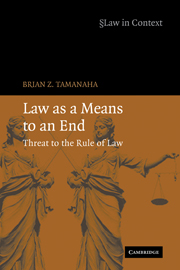Introduction
Published online by Cambridge University Press: 25 July 2009
Summary
An instrumental view of law – the idea that law is a means to an end – is taken for granted in the United States, almost a part of the air we breathe. This operates in various ways: as an account of the nature of law, as an attitude toward law that professors teach students, as a form of constitutional analysis, as a theoretical perspective on law, as an orientation of lawyers in their daily practice, as a strategic approach of organized groups that use litigation to further their agendas, as a view toward judges and judging, as a perception of legislators and administrators when enacting laws or regulations. In all of these contexts, people see law as an instrument of power to advance their personal interests or the interests or policies of the individuals or groups they support. Today, law is widely viewed as an empty vessel to be filled as desired, and to be manipulated, invoked, and utilized in the furtherance of ends.
A few centuries ago, in contrast, law was widely understood to possess a necessary content and integrity that was, in some sense, given or predetermined. Law was the right ordering of society binding on all. Law was not entirely subject to our individual or group whims or will. There were several versions of this. Law was thought to consist of rules or principles immanent within the customs or culture of the society, or of God-given principles disclosed by revelation or discoverable through the application of reason, or of principles dictated by human nature, or of the logically necessary requirements of objective legal concepts.
- Type
- Chapter
- Information
- Law as a Means to an EndThreat to the Rule of Law, pp. 1 - 8Publisher: Cambridge University PressPrint publication year: 2006

